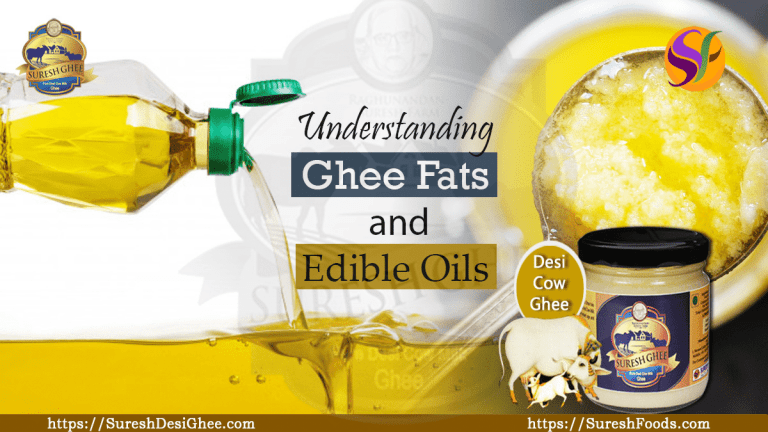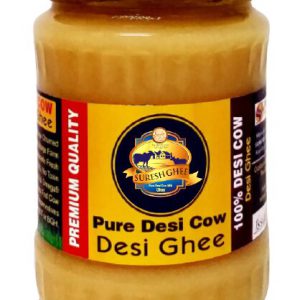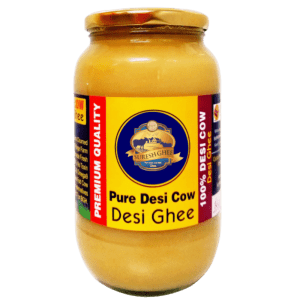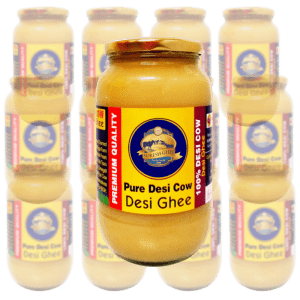Desi Ghee is commonly referred to as clarified butter, is a natural and traditional source of fat often used in Indian kitchens for cooking especially in winters. But these days to maintain fitness, people have started cutting down on ghee and have started to include refined oils in their kitchen which are much more harmful.
On the other hand, refined oils are obtained after treating natural oils with various chemicals and therefore, oil has disadvantages that can turn out to be harmful in the long run. Nickel is a type of chemical, which is used in the refinement process which has adverse effects on the liver, skin and respiratory system. In addition to this, refined oils have also been linked with diseases such as cancer, diabetes, stroke, and kidney ailments.
Desi Ghee
Ghee is prepared by simmering butter until the water gets evaporated. In this process, the milk solids are removed. It is called clarified butter, which is one of the best cooking oil in the kitchen.
But unfortunately, ghee is replaced by other cooking oils in the present scenario. Ghee has a high smoking point which also means that it does not produce tissue-damaging free radicals in the body. It is not bulky to the stomach, unlike butter or vegetable oils.
Ghee contains both saturated and unsaturated fats. Saturated fat consists of easily digested short-chain fatty acids. Short-chain fatty acids strengthen and develops cell membranes. Ghee does have saturated fats but not trans fat, unlike pizzas or burgers which actually causes harm to the body.
It has heart-healthy saturated fats which also produces Vitamin B12 in the body. When saturated fat does not exceed the calories limit, it does not cause any harm to the body. It has various health benefits which are very beneficial to the body.
Essential fats are one of the important aspects responsible for the proper functioning of the body. Ghee is loaded with a huge content of Vitamin A, D, E and K. Omega 6 fatty acids and Omega 3 fatty acids play a role to promote an anti-inflammatory property.
It also has butyric acid which acts as an antioxidant. Thus, this property of ghee will help in curing heart disease and stop cancer-causing cells. Beyond the consumption of ghee for health benefits, it also has various beauty benefits as well.
At least a spoonful of ghee must be added to one’s diet every day. As it looks after the overall development of one’s health. It also eases digestion, provides moisturization and also acts as a lubricator. In Ayurveda ghee is used for various treatments from ancient times.
Besides the health benefits and medicine, it also has an amazing taste and a bold aroma. It can make the boring khichdi tasty, the plain dal tastier and brighter by ghee tadka (tempering) and spreading ghee over chapatis or parathas. It also gives richness to the food. For people with lactose intolerance, it can be the best oil.
Read our blog – THE VIRTUES OF DESI COW GHEE
Buy cow Ghee Online : Order Now. Free Shipping
Edible oils
There are various types of edible oils like coconut oil, corn oil, peanut oil, sunflower oil and soybean oil etc. Usually, edible oils are plant-based oils. The carboxyl group makes the oils edible, providing a site for our enzymes to attack and break down the chain in a process called beta-oxidation.
The lengths of the hydrocarbon chains determine whether they are saturated or not, or unsaturated in a cis or trans conformation. It also determines how easily they are metabolized and how healthy or unhealthy they are for daily usage in the kitchen.
Some common edible oils which are used at homes are sunflower oils, olive oils and coconut oils. Monounsaturated and polyunsaturated oils are considered better choices for health. Vegetable oils are usually heavily processed and high in trans-fat.
Olive oils
Olive oil is rich with fruity flavour. It is a monounsaturated oil that helps in reducing heart risk, diabetes and certain cancer-causing cells. It is also used to cure inflammation in the stomach.
Coconut oils
Coconut oil tastes like raw coconuts and gives a tropical flavour to the food. It has medium-chain fatty acids which act as an antiviral and antifungal agent.
Sunflower oil
Sunflower oil has a sweet sunflower flavour. It is a mixture of polyunsaturated fat and linoleic acid(59%); monounsaturated fat and oleic acid(30%). It is mainly triglyceride.
It is rich in Vitamin E.
| (100 gm) | Ghee | Olive oil | Coconut oil | Sunflower oil |
| Calories | 900 calories | 900 calories | 900 calories | 884 calories |
| Total fat | 99.5 gm | 100 gm | 99 gm | 100 gm |
| Trans fat | 4 gm | 0 gm | 0 mg | 0 mg |
| Cholesterol | 256 mg | 0 mg | 0 mg | 0 mg |
Why edible oils or vegetable oils are harmful?
The invention of vegetable oils was made to produce a cheaper substitute for cooking oil as people used cold-pressed oils or milk-based fats like butter, ghee and cream etc. Oil refining is a seven-step process involving the addition and removal of chemicals.
The heating of most of the edible oil will turn it rancid too quickly. Rancidity is a cause of high LDL cholesterol due to the inflammation of the arteries. The chemical nickel is used to refine the vegetable oil which is implicated in a few effects on the respiratory system, digestive system, liver and skin etc.
The hydrogenated and refined oils can turn to be harmful in the long run. They contain a high content of polyunsaturated fats which are unstable. The oxidised fats can cause mutation and inflammation in cells.
Buy cow Ghee Online : Order Now. Free Shipping
Read our blog – Ghee – Is it a friend or foe?
Health and Nutrition of Ghee and oil
The whole nutrition scenario and value are now supportive of Desi ghee. Ghee is now looked upon as one of the best cooking mediums because of the following reasons:
- Ghee is rich in antioxidants and can combat free radicals. Compared to refined oils oxidize beyond their smoke point and can even cause free radicals. These free radicals are much more dangerous in nature as it is cancerous in character. Coconut oil and Olive oil are known to be healthy in nature but have a lower smoke point compared to ghee.
- Ghee has a healing effect. It can reduce inflammation inside the stomach as well as in the outer body. Ghee is good to heal wounds, cuts, and burns. It has a cooling property as well. Desi ghee is also great for the stomach and intestines.
- Ghee has many essential short-chain fatty acids like CLA and DHA. Ghee also has many vitamins like vitamins A, D, E, and K that are fat soluble.
Now ghee is also recommended for weight loss as well. In contrast, refined oils can undergo hydrogenation which can create trans-fats, which are extremely harmful in nature. So the oils are bad for health.
Is desi ghee better than edible oils?
Yes! The ghee which is not adulterated is surely the essential fat which your body uses for its benefit. Unlike vegetable oils or edible oils, desi cow ghee does not contain polyunsaturated fats. Ghee also has higher shelf life than edible oils. It also has a higher smoking point than edible oils. Ghee contains various health benefits as mentioned above.
Analyzing Unique Qualities: Ghee vs. Cooking Oil
In the domain of culinary adventures, sometimes the paramount to enticing taste buds lies in migrating beyond the traditional. A monotonous argument mostly takes place : which is superior, the beneficial ghee or the versatile cooking oil? Let’s get into the variations and distinctions to help you make an informed selection.
Ghee: A Refined Essence of Butter
Ghee is not just butter; it’s a clarified essence obtained through a thorough heating procedure. Its use mostly targets to minimize spillage and shields from mingling with residual fats. As butter goes through heat, froth emerges, and such froth is carefully filtered to sustain the golden liquid underneath. The final product, ghee, sticks out as a pure and clarified form of butter.
Cooking Oil: Pure, Unadulterated Fat
On the contrary, cooking oil is the representation of pure, unadulterated fat. Not vulnerable to frothing like butter, cooking oil is mostly recognised as a straightforward conductor of heat, defining significant characteristics that are stickiness and greasiness.
Origins and Processing: A Tale of Transformation
The production process further sets these two culinary stalwarts apart. Cooking oils can be obtained from an array of seeds, going through the clarification processes that convert taste and aroma. Sunflower seed oil, for a moment, undergoes compression and following refinement to gain the similar appearance viewed on store shelves.
Electrical Conductivity and Texture: Noteworthy Differences
A distinct characteristic of cooking oil is its deficiency of electrical conductivity, creating it corresponding to water in terms of electric charge. On the tangible front, it’s mostly determined as “sticky” or “greasy,” stressing on its significant texture.
Ghee in Cooking and Baking:
Ghee is useful to the cook or as a baker, in sauces, as a smear, and for coating pans, frying, and sauteing. The ghee has been sterilized to remove the milk solids and water from the butterfat.
It is provided by heating butter until the fat, milk solids and water get evaporated by density. It is clear when heated. In India, clarified heated butter is called ghee, which has a high smoke point and is the ultimate solution for frying and sauteing.
Other types of ghees are described by the following:
- Cultured ghee: It is made from milk cream that has been processed through some fermentation process of its milk sugar level. Lactic acid bacteria create the fermentation and stimulate a sharp “cultured” taste sense. Cultured butter is mostly preferred butter in most of Europe.
- Pasteurized ghee: This characteristic of ghee is available in the United States. It is made from cream that has undergone the pasteurization process of milk, which kills naturally all kinds of bacteria. This makes it unlike cultured butter in taste.
- Raw-cream ghee: It originated from the farm-fresh, unpasteurized clean creamy in taste. It has a smaller shelf life than pasteurized butter.
- Salted ghee: This is present in both cultured and uncultured ghee. Salted butter that includes sea salt.
- Whipped ghee: It gets whipped with nitrogen gas after it has been churned by bilona. Softness is more at cool temperatures. Due to whipped butter being low in density, it is a less preferable choice for cooking and baking and is best used for a smear purpose.
Make sure you are buying grass fed ghee which is made by A2 milk. Adulterated ghee will not lead you to health benefits. Besides adulteration, pure desi ghee should be consumed in a moderate amount. Too much consumption of ghee can be harmful to the body. Organic grass fed cow ghee is one of the best ghee you can give yourself and your family. Buy the best desi ghee at our online store https://sureshfoods.com/.







 WhatsApp us
WhatsApp us
Naveen m...